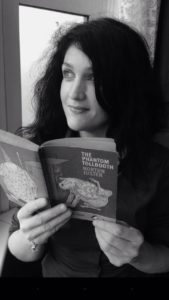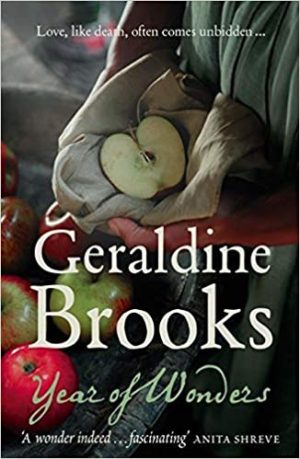It is 1666 and the plague reaches a remote Derbyshire village of some 360 souls. They decide to cut themselves off from the outside world in order to protect the surrounding villages. Based on a true story, Year of Wonders by Geraldine Brooks is a haunting and poignant novel told through the voice of an 18-year-old village girl. Although published twenty years ago it has, of course, extra resonance for our times.
I can’t believe I had never heard about this book. Geraldine Brooks is an Australian journalist and novelist who now lives in the US. She was drawn to this story when on holiday in Derbyshire and noticed signs pointing to a ‘plague village’. Her research revealed that the rector of the church at the time persuaded the villagers to go into voluntary isolation and in effect sacrifice themselves for the greater good. Over half of them perished: mostly babies, children and young working people. Sharp Bookstokers may recall at the height of the first 2020 lockdown there was a BBC news piece which featured the modern inhabitants of the same village and how they were coping with another pandemic.
In the novel, young widow Anna, struggling to make ends meet with two small boys, takes in a lodger – a tailor. He receives a bolt of cloth which contains fleas from infected rats and becomes the first victim in the village of the plague. On his deathbed he realises he has made clothes for several villagers and instructs Anna to burn them all. No one but Anna is willing to give up their new garments and the disease radiates out from her cottage ‘like a starburst’.
Anna and the rector Michael Mompellion, with his wife Elinor, are at the heart of this story. Together they tend to the souls and bodies of the villagers, learning about healing herbs and delivering babies even as the plague ravages each humble dwelling in turn.
‘By afternoon we had assembled the weapons for our armoury. Nettles for the blood. Starwort and violet leaves for the lungs. Silverweed to cool a fever. Cress for the stomach. The warts of blow-ball for the liver, batweed for the glands and vervain for the throat’.
These selfless acts are set against their opposite as some villagers succumb to superstition, theft, profiteering and madness. Brooks is excellent in conjuring the customs and vocabulary of the time, from sheep farming to lead mining and from 17th century medical lore to the landscape:
‘There are some who might deem this mountainside bleak country, and I can see how it might seem so: the land all chewed up by the miners, their stows like scaffolds upon the moors, and their bings like weedy molehills interrupting the pale mauve tide of the heather. This is not a vivid place. Our only strong hue is green, and this we have in every shade: the emerald velvet mosses, the glossy, tangled ivies, and, in spring, the gold-greens of tender new grasses’
While we might need to suspend a bit of disbelief to imagine that an illiterate young girl has been schooled by the rector’s wife to the extent that she picks up herbalism, Latin and midwifery easily, Anna is an appealing narrator – a kind of everywoman who suffers appalling losses yet who gives without expectation of return, and who has an admirably forthright nature. There is so much love in this book, and so much sadness and horror, and so many ways to think about what it means to live a good life. And the ending is absolutely perfect.
If you loved Hamnet and can bear another book about children dying from bubonic plague…this could be your next read.
Year of Wonders by Geraldine Brooks is published by Harper Perennial, 336 pages.





